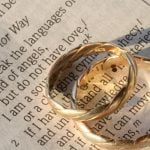Have you ever wondered what hand is the wedding ring worn on? The significance and placement of wedding rings have varied throughout history and across different cultures. From the symbolism of the ring to religious and traditional customs, the choice of which hand to wear a wedding ring on holds great importance.
In this article, we will explore the history, symbolism, cultural variances, traditions, and religious significance of wedding ring placement. Additionally, we will look at modern trends and provide tips for choosing the right hand for your wedding ring.
The tradition of exchanging rings dates back thousands of years, with evidence of ancient Egyptians using rings as a symbol of eternity. Throughout history, the concept of wedding rings has evolved in different ways among various civilizations. Understanding this historical context can provide insight into the significance of where a wedding ring is placed on which hand.
From representing love and commitment to signifying unity and infinity, wedding rings carry profound symbolism. The meaning behind these symbols has influenced cultural beliefs about where a wedding ring should be worn. Different cultures have their own customs regarding which hand is considered appropriate for wearing a wedding ring, reflecting unique perspectives on marriage and love.
As we delve into the history and symbolism surrounding wedding rings, we will also examine contemporary trends in wedding ring placement. Understanding these trends can help couples navigate through the decision-making process when it comes to choosing which hand to wear their wedding ring on.
Symbolism of Wedding Rings
The wedding ring has been a symbol of love and commitment for centuries, with its origins dating back to ancient Egypt and Greece. The circular shape of the ring represents eternity, with no beginning or end, symbolizing the everlasting nature of marriage. The opening in the center of the ring signifies a gateway or door leading to unknown adventures and experiences that the couple will face together.
In many cultures, the exchange of rings during a wedding ceremony is seen as a powerful symbol of unity, love, and respect between partners. It is a physical representation of the vows and promises made during the wedding ceremony. The wedding ring is worn on a specific finger because it is believed that this finger contains a vein that leads directly to the heart, further representing the deep emotional connection and love between spouses.
Some popular cultural variances in wedding ring placement include wearing the ring on different hands depending on religious beliefs and customs. For example, in some countries such as Russia, Germany, India, and Colombia, the wedding ring is traditionally worn on the right hand. Understanding these cultural differences can help couples make an informed decision about which hand would be most appropriate for their unique situation.
- Religious Significance of Wedding Ring Placement
- Modern Trends in Wedding Ring Placement
- Traditions and Customs of Wedding Ring Placement
Cultural Variances in Wedding Ring Placement
The placement of wedding rings varies across different cultures and traditions. In Western countries, it is customary for couples to wear their wedding rings on the fourth finger of their left hand, also known as the “ring finger.” This tradition can be traced back to ancient Roman beliefs that the vein in this finger, called the “vena amoris” or “vein of love,” is directly connected to the heart.
However, not all cultures follow this practice. In some Eastern European and South American countries, for example, it is more common for couples to wear their wedding rings on their right hand.
In India, the placement of the wedding ring also varies depending on the region and religious beliefs. In some parts of India, particularly in Hindu culture, it is customary for women to wear the wedding ring on the toe rather than on the finger. This tradition symbolizes a woman’s marital status and is considered an auspicious adornment. Additionally, in Jewish tradition, the wedding ring is traditionally placed on the index finger during the marriage ceremony.
Furthermore, there are cultures where both partners may wear matching wedding rings on a specific hand or fingers to symbolize their union. For example, in some Scandinavian countries such as Norway and Denmark, it is common for couples to exchange rings during their engagement and wear them on their right hands until they are married. After marriage, they move the ring to their left hand to signify their new status as a married couple.
These cultural variances highlight how diverse practices and beliefs influence wedding ring placement around the world. Understanding these differences allows for a greater appreciation of each culture’s unique customs when it comes to celebrating love and union through marriage.
Traditions and Customs of Wedding Ring Placement
When it comes to the placement of wedding rings, traditions and customs play a significant role in determining which hand the ring is worn on. Throughout history and across various cultures, there have been different practices associated with where the wedding ring should be placed. Here are some common traditions and customs related to wedding ring placement:
1. Western Tradition: In many Western countries, including the United States and most of Europe, it is customary for the wedding ring to be worn on the fourth finger of the left hand. This tradition dates back to ancient Roman times when it was believed that a vein ran directly from this finger to the heart, symbolizing love and affection.
2. Eastern Tradition: In contrast to Western tradition, many Eastern cultures, such as those in India and Russia, place the wedding ring on the fourth finger of the right hand. In these cultures, the right hand holds more significance and is considered more auspicious for wearing jewelry and performing important rituals.
3. Jewish Tradition: In Jewish tradition, there is a custom known as “betrothal rings” where both partners wear rings on their right hands during their engagement period. Once married, the bride may move her ring to her left hand or continue wearing it on her right hand.
Regardless of cultural variances in wedding ring placement, what remains consistent is the symbolism behind wearing a wedding ring. It serves as a visible symbol of love and commitment between partners, regardless of which hand it is worn on. As couples embrace modern trends and individual preferences, it becomes essential to consider what feels most meaningful for them when deciding on which hand to wear their wedding rings.
Religious Significance of Wedding Ring Placement
Wedding ring placement holds significant meaning in various religious traditions, shaping the customs and practices followed by couples around the world. The religious significance of wedding ring placement often reflects the beliefs and values held by different faiths, with specific guidelines dictating the proper hand on which to wear the wedding ring.
Christianity
In Christianity, the wedding ring is traditionally worn on the fourth finger of the left hand, also known as the “ring finger.” This custom is based on the belief that this finger contains a vein that leads directly to the heart, symbolizing the deep connection and love between spouses. The circular shape of the wedding ring further represents eternity and unending love.
Judaism
In Jewish tradition, wedding rings are often placed on different fingers depending on whether it’s a man’s or woman’s ring. During a traditional Jewish wedding ceremony, both partners exchange rings under the chuppah (wedding canopy). While there are differing views on which hand should hold each partner’s wedding ring during this ceremony, some Jewish couples choose to wear their rings on their right hand after marriage.
Hinduism
In Hindu weddings, rings may be exchanged but are not considered a compulsory part of marriage ceremonies. However, if a couple does exchange rings, they may choose to wear them on different hands or fingers according to personal preference and regional customs within Hindu culture.
Understanding the religious significance of wedding ring placement can help couples honor their faith traditions while deciding where to wear their precious symbol of commitment and love.
Modern Trends in Wedding Ring Placement
In modern times, there has been a shift in the traditional placement of wedding rings. While for many years, the left hand was considered the only proper place for a wedding ring, nowadays, couples are experimenting with different locations.
Some are choosing to wear their wedding ring on the right hand to symbolize independence and individuality within the marriage. This trend has become particularly popular among women who want to break away from the old-fashioned notion that a wedding ring must be worn on the left hand.
Furthermore, another modern trend in wedding ring placement is wearing matching rings on different fingers. Some couples opt to wear their engagement ring and wedding band on separate hands as a way to showcase both pieces of jewelry.
Additionally, some individuals choose to honor special relationships or achievements by wearing their wedding ring on a different finger altogether. For example, those who achieved a major career milestone may choose to wear their wedding ring on their dominant hand as a celebration of success.
It’s clear that modern trends in wedding ring placement have evolved significantly from traditional customs. Couples today are seeking unique and personal ways to express their love and commitment through the placement of their wedding rings.
| Modern Trend | Description |
|---|---|
| Wearing on right hand | Symbols independence and individuality within the marriage |
| Matching rings on different fingers | To showcase both pieces of jewelry |
| Wearing on different fingers | To honor special relationships or achievements |
The Significance of the Left Hand
The tradition of wearing a wedding ring on the left hand dates back to ancient Egypt, where it was believed that the fourth finger on the left hand contained a vein that led directly to the heart, known as the “vena amoris” or “vein of love.” This symbolism has carried through the centuries and is still widely recognized today. The circular shape of the ring also represents eternity and everlasting love, making it a perfect symbol for marriage.
In many Western cultures, including North America and Europe, the wedding ring is traditionally worn on the left hand. However, there are some cultural variances in wedding ring placement around the world. For example, in some Eastern European countries such as Russia and Bulgaria, the wedding ring is worn on the right hand. In India, it varies by region – in some parts, both men and women wear their rings on their right hands after marriage.
While many modern couples choose to follow traditional customs and wear their wedding rings on their left hands, there is increasing flexibility and freedom in choosing which hand to wear your wedding ring on. Ultimately, what hand is the wedding ring worn on depends on personal preference, cultural background, and religious beliefs.
| Country | Wedding Ring Placement |
|---|---|
| United States | Left Hand |
| Russia | Right Hand |
| Bulgaria | Right Hand |
| India (varies by region) | Right/Left Hand |
Tips for Choosing the Right Hand for Your Wedding Ring
In conclusion, the placement of a wedding ring holds significant cultural, traditional, and religious meanings. Throughout history, the wedding ring has been perceived as a symbol of love and commitment, regardless of the hand it is worn on. While there are variations in wedding ring placement across different cultures and traditions, the left hand has remained the most widely accepted choice for wearing a wedding ring.
Understanding the significance of the left hand in wedding ring placement can help couples make an informed decision when choosing which hand to wear their rings on. The left-hand tradition dates back centuries and continues to be embraced by various religions and cultures. However, modern trends have seen some couples opting for alternative placements based on personal preference or cultural background.
When it comes to choosing the right hand for your wedding ring, it is important to consider both personal preference and cultural significance. Whether you choose to follow traditional customs or forge your own path, what truly matters is the love and commitment represented by the rings themselves – no matter which hand they adorn. Ultimately, the decision of what hand to wear a wedding ring on is a personal one that should hold sentimental value for each individual and couple.
Frequently Asked Questions
What Does Wearing Wedding Ring on Right Hand Mean?
Wearing a wedding ring on the right hand can have different meanings depending on the culture. In some countries, it may signify a recent engagement or being unmarried, while in others, it may indicate a divorcee or widow.
Why Do You Wear a Wedding Ring on Your Left Hand?
The tradition of wearing a wedding ring on the left hand dates back to ancient Egypt, where it was believed that the fourth finger on the left hand had a vein that directly connected to the heart. This led to the practice of placing the wedding ring on this finger as a symbol of love and commitment.
Which Hand Does a Woman Wear His Wedding Ring?
Traditionally, women wear their wedding rings on their left hand, specifically on the fourth finger. This is a widely accepted custom in many cultures and is believed to have originated from the ancient Egyptian belief about the vein leading directly to the heart.

Welcome to my blog about home and family. This blog is a place where I will share my thoughts, ideas, and experiences related to these important topics. I am a stay-at-home mom with two young children. I hope you enjoy reading it! and may find some helpful tips and ideas that will make your home and family life even better!





